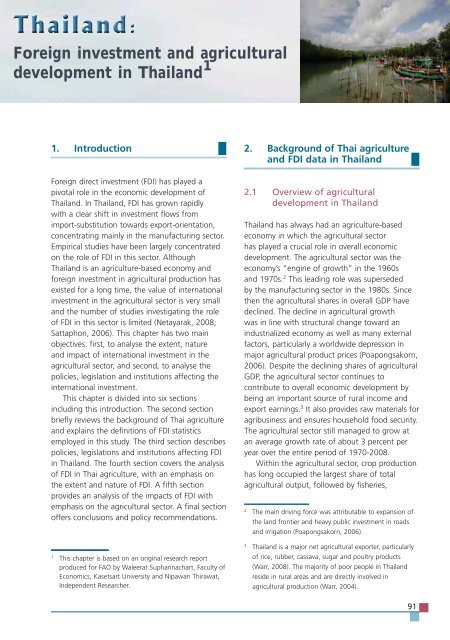TRENDS AND IMPACTS OF FOREIGN INVESTMENT IN DEVELOPING COUNTRY AGRICULTURE
TRENDS AND IMPACTS OF FOREIGN INVESTMENT IN DEVELOPING COUNTRY AGRICULTURE
TRENDS AND IMPACTS OF FOREIGN INVESTMENT IN DEVELOPING COUNTRY AGRICULTURE
Create successful ePaper yourself
Turn your PDF publications into a flip-book with our unique Google optimized e-Paper software.
:<br />
Foreign investment and agricultural<br />
development in Thailand 1<br />
1. Introduction <br />
Foreign direct investment (FDI) has played a<br />
pivotal role in the economic development of<br />
Thailand. In Thailand, FDI has grown rapidly<br />
with a clear shift in investment flows from<br />
import-substitution towards export-orientation,<br />
concentrating mainly in the manufacturing sector.<br />
Empirical studies have been largely concentrated<br />
on the role of FDI in this sector. Although<br />
Thailand is an agriculture-based economy and<br />
foreign investment in agricultural production has<br />
existed for a long time, the value of international<br />
investment in the agricultural sector is very small<br />
and the number of studies investigating the role<br />
of FDI in this sector is limited (Netayarak, 2008;<br />
Sattaphon, 2006). This chapter has two main<br />
objectives: first, to analyse the extent, nature<br />
and impact of international investment in the<br />
agricultural sector, and second, to analyse the<br />
policies, legislation and institutions affecting the<br />
international investment.<br />
This chapter is divided into six sections<br />
including this introduction. The second section<br />
briefly reviews the background of Thai agriculture<br />
and explains the definitions of FDI statistics<br />
employed in this study. The third section describes<br />
policies, legislations and institutions affecting FDI<br />
in Thailand. The fourth section covers the analysis<br />
of FDI in Thai agriculture, with an emphasis on<br />
the extent and nature of FDI. A fifth section<br />
provides an analysis of the impacts of FDI with<br />
emphasis on the agricultural sector. A final section<br />
offers conclusions and policy recommendations.<br />
1 This chapter is based on an original research report<br />
produced for FAO by Waleerat Suphannachart, Faculty of<br />
Economics, Kasetsart University and Nipawan Thirawat,<br />
Independent Researcher.<br />
2. Background of Thai agriculture<br />
and FDI data in Thailand <br />
2.1 Overview of agricultural<br />
development in Thailand<br />
Thailand has always had an agriculture-based<br />
economy in which the agricultural sector<br />
has played a crucial role in overall economic<br />
development. The agricultural sector was the<br />
economy’s “engine of growth” in the 1960s<br />
and 1970s. 2 This leading role was superseded<br />
by the manufacturing sector in the 1980s. Since<br />
then the agricultural shares in overall GDP have<br />
declined. The decline in agricultural growth<br />
was in line with structural change toward an<br />
industrialized economy as well as many external<br />
factors, particularly a worldwide depression in<br />
major agricultural product prices (Poapongsakorn,<br />
2006). Despite the declining shares of agricultural<br />
GDP, the agricultural sector continues to<br />
contribute to overall economic development by<br />
being an important source of rural income and<br />
export earnings. 3 It also provides raw materials for<br />
agribusiness and ensures household food security.<br />
The agricultural sector still managed to grow at<br />
an average growth rate of about 3 percent per<br />
year over the entire period of 1970-2008.<br />
Within the agricultural sector, crop production<br />
has long occupied the largest share of total<br />
agricultural output, followed by fisheries,<br />
2 The main driving force was attributable to expansion of<br />
the land frontier and heavy public investment in roads<br />
and irrigation (Poapongsakorn, 2006).<br />
3 Thailand is a major net agricultural exporter, particularly<br />
of rice, rubber, cassava, sugar and poultry products<br />
(Warr, 2008). The majority of poor people in Thailand<br />
reside in rural areas and are directly involved in<br />
agricultural production (Warr, 2004).<br />
91


